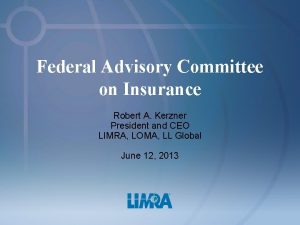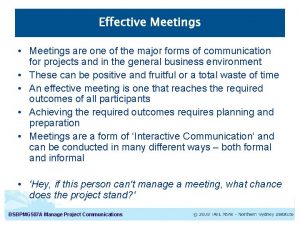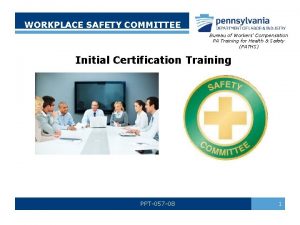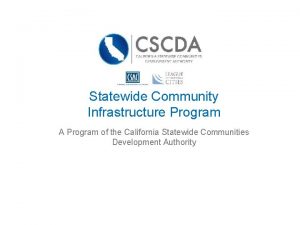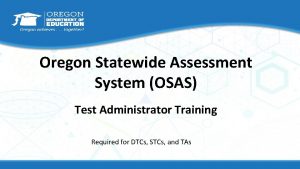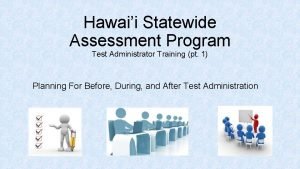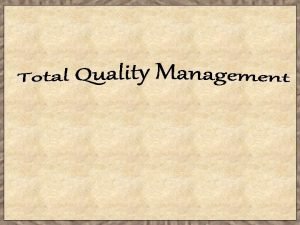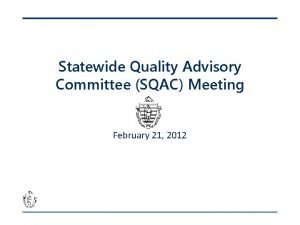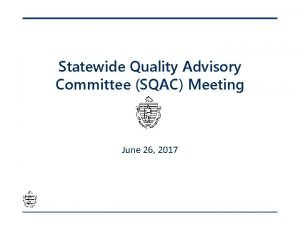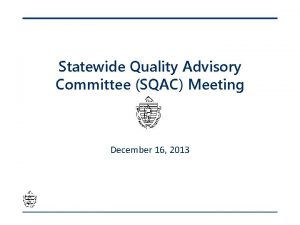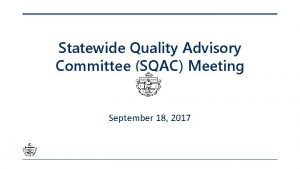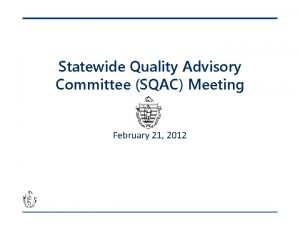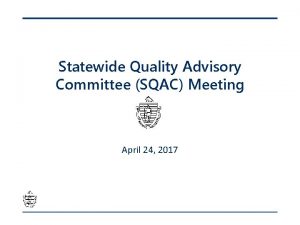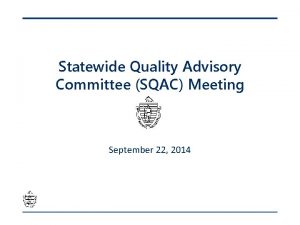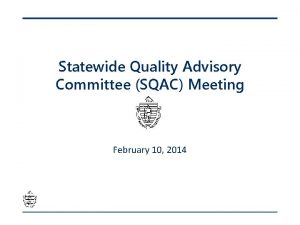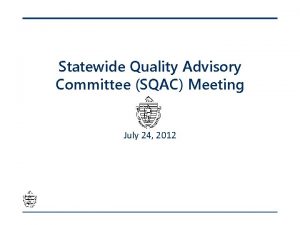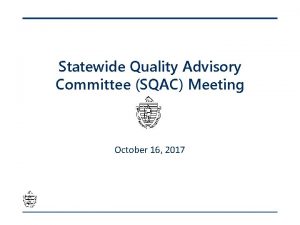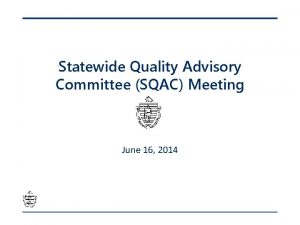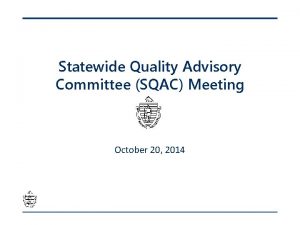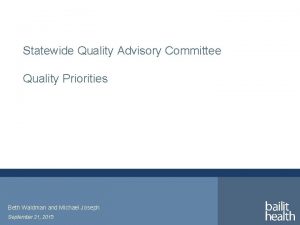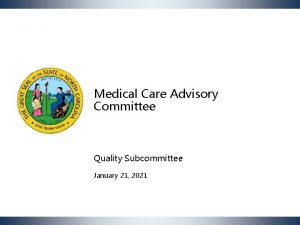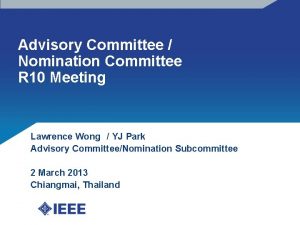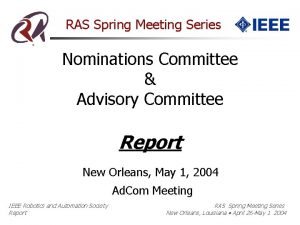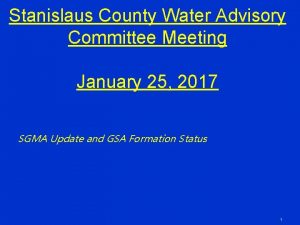Statewide Quality Advisory Committee SQAC Meeting January 25

































- Slides: 33

Statewide Quality Advisory Committee (SQAC) Meeting January 25, 2012

Agenda • • • Welcome and Introduction Overview of DPH Regulatory Process Committee Bylaws Review Of Key Materials Next steps 2

Commissioners Auerbach and Boros WELCOME AND INTRODUCTION 3

Committee Members • • • Áron Boros, Commissioner, Division of Health Care Finance and Policy John Auerbach, Commissioner, Department of Public Health Dolores Mitchell, Executive Director of the Group Insurance Commission Dr. Julian Harris, Director of Mass. Health – Designee: Dr. David Polakoff, Chief Medical Officer, Commonwealth Medicine Dianne Anderson, President and CEO, Lawrence General Hospital - a representative from an acute care hospital or hospital association Dr. James Feldman, Boston University Medical Center and Massachusetts Medical Society – a representative from a provider group, medical association or provider association Dr. Richard Lopez, Chief Medical Officer, Harvard Vanguard Medical Associates - a representative from a medical group Jon Hurst, President, The Retailers Association of Massachusetts - a representative from an employer association Amy Whitcomb Slemmer, Executive Director, Health Care For All - a representative from a health care consumer group 4

Context of Standard Quality Measures and Health Reform • • • Enhanced transparency of system performance Expanded insurance coverage Cost containment efforts Persistent quality gaps despite improvement efforts Multiple efforts – private and public – at performance measurement 5

Role of Committee and its Advisory Recommendations • The SQAC will identify and endorse measures for inclusion in the Standard Quality Measure Set and recommend future priorities for quality measurement. • With regard to measure identification, the SQAC will issue annual recommendations to the Department for the Standard Quality Measure Set. 6

Committee Meeting Schedule #1 Jan 25 1. Introductions 2. Scope of Task 3. DPH Regulatory Process 4. Adopt Bylaws #2 Feb 21 1. Review Mandated Measures 2. Nominate Other Measures for Review 3. Preliminary “Straw Poll” on Measure Recommendations Quality Measurement Webinar #3 March 1. Review of Formal Approval 2. Discuss Additional Measures Proposed in Meeting #2 #4 March Discuss Priority Area of Measurement #5 April Discuss Priority Area of Measurement #6 May 1. Discuss Priority Area of Measurement 2. Review & Discuss Draft Report #7 May 1. Approve Final Report 2. Approve Priorities for 2013 Experts to Discuss Potential Measures 7

Vote on Remote Participation • The co-chairs recommend remote participation subject to Open Meeting Law (OML): – Circumstances that meet the standards of unreasonable difficulty and in which a quorum of the public body is physically present, in alignment with OML guidelines and as adjudicated on a case-bycase basis by the Co-Chairs. – No committee member may utilize the remote participation function of OML for more than two meetings per year. 8

Commissioner Auerbach DEPARTMENT OF PUBLIC HEALTH REGULATORY PROCESS 9

DPH Regulatory Process 1. 2. 3. 4. 5. 6. DPH staff prepares proposed regulation and explanatory memo (at least 4 weeks before Public Health Council (PHC) meeting) DPH staff presents proposed regulation and memo to PHC Public hearings held (at least 3 weeks after PHC meeting) and comment period closes DPH staff reviews comments, revises regulation and memo as needed (at least 4 weeks before PHC meeting) DPH staff presents final regulation and memo to PHC for promulgation Final regulation published in Massachusetts Register (at least 3 weeks after PHC meeting) 10

Commissioner Boros COMMITTEE BYLAWS 11

Committee Bylaws Overview • • Statutory Reference Open Meeting Law Bylaws Overview Committee Scope, Process and Structure Nominating Non-Mandatory Measures for Evaluation Approach to Evaluation of Measures Process Annual Reporting Process 12

Committee Bylaws • Brief discussion and vote. 13

Commissioner Auerbach and John Freedman REVIEW OF KEY MATERIALS 14

Principles for Measure Selection • In assessing measures for inclusion in the recommended Standard Quality Measure Set, three areas will be evaluated prior to endorsement: – Priority – Validity – Practicality 15

Priority • Measure or measure set meets priority areas specified by Commissioners. 16

Priority Areas • The year-one focus for the SQAC selection and evaluation process will be quality measures that will aid state government in measuring the performance of integrated healthcare systems, such as ICOs, ACOs, and PCMHs. The development of such systems is critical to the state goal of encouraging high-quality, coordinated, and affordable healthcare. The opportunity for the SQAC to assist in developing the means to measure the success of this initiative will support state efforts to monitor the transformation of the delivery system. 17

Priority Areas • • • Efficiency and system performance Care transitions and coordination High-priority settings and clinical focus areas – Mandated measures – Non-mandated measures 18

Validity • Validity: measures should be sound, just, and well-founded in accordance with HCQCC principles 1, 3, 5 & 6. 1. 3. 5. 6. Wherever possible, measures should be drawn from nationally accepted standard measure sets There must be empirical evidence that the measure provides stable and reliable information, and that the data sources and sample sizes are sufficient for accurate reporting at the level chosen There must be empirical evidence that the measured entity (clinician, site, group, institution) is associated with a significant amount of the variance in the measure. The measures offered for providers should, in totality, be representative of a significant proportion of their practices, OR the measure is important for patients or communities, even though a clear consensus on accountability for performance has not been determined Providers should be informed about the development and validation of the measures and given the opportunity to view their own performance, ideally for one measurement cycle, before the data are used for public reporting. Where feasible, providers should be permitted to verify data and offer corrections 19

Practicality • Practicality: measures that are pragmatic, able to be applied without extensive additional work, and meet the practical considerations of this project/program in accordance with HCQCC principles 2 & 4. – Ease of data collection (e. g. , existing efficient process in place vs. data unavailable) – HCQCC 2. The measure must reflect something broadly accepted as meaningful to providers or patients – HCQCC 4. There must be sufficient variability or insufficient performance on the measure to merit attention 20

Validity/Practicality Grid • Work group staff and consultants will assign preliminary quantitative ratings to each measure for each aspect. For further consideration, a measure must meet a minimum threshold of validity and practicality. All measures meeting this threshold will then be grouped based on their scores on Validity and Practicality, as seen below. Sufficient Practicality Sufficient Validity Insufficient Practicality Strongest recommendation Measure is considered valid, but further infrastructure development is needed for a strong recommendation Measure is considered not sufficiently valid, and further work on the methodology is needed for a strong recommendation Weakest recommendation 21

Mandated Measure Sets • CMS Hospital process measures for: – – • • • Heart attacks Congestive heart failure Pneumonia Surgical infection prevention The US Department of Health and Human Services’ Hospital Consumer Assessment of Healthcare Providers and Systems Survey (HCAHPS). The Healthcare Effective Data and Information Set (HEDIS). The Massachusetts Ambulatory Care Experiences Survey (ACES). 22

CMS Hospital Process Measures • • Measures quality at all CMS participating hospitals for Heart Attack (AMI), Heart Failure, Pneumonia, and Surgical Infection Prevention Data are publicly reported on Hospital Compare, the CMS consumer website, and My. Health. Care. Options, the state consumer website 23

CMS Process of Care: Hospital Compare website 24

Hospital Consumer Assessment of Healthcare Providers & Systems Survey (HCAHPS) • • • Standardized survey instrument and data collection methodology for measuring patients' perspectives on hospital care 8 domains covered including communication with doctors, communication with nurses, responsiveness of hospital staff, and pain management Publicly reported on Hospital Compare and My. Health. Care. Options 25

HCAHPS: My. Health. Care. Options website 26

Healthcare Effectiveness Data and Information Set (HEDIS) • • Tool used by more than 90% of America's health plans to measure performance on important dimensions of care & service Consists of 71 measures across 8 domains of care Publicly reported for most health plans by the National Committee on Quality Assurance (NCQA) A subset of 24 HEDIS measures is publicly reported for ~150 MA medical groups by MA Health Quality Partners (MHQP), and displayed on My. Health. Care. Options 27

Ambulatory Care Experiences Survey (ACES) • • Brief patient-completed questionnaire that evaluates patients' experiences with a specific physician and that physician's practice Mostly concerned with: – Quality of MD-Patient Interactions – Organizational Features of Care • ACES is publicly reported for over 400 MA medical practice sites by MHQP 28

Catalog of Additional Potential Measures • Work group staff and consultants have compiled a catalog of additional potential measures that include methodologies developed by: – Agency for Healthcare Research and Quality (AHRQ) • Prevention Quality Indicators • Inpatient Quality Indicators • Patient Safety Indicators • Pediatric Quality Indicators. – CMS Physician Quality Reporting System – Various state and regional quality coalitions and collaboratives 29

NEXT STEPS 30

Process for Nominating Additional Potential Measures • • Each member of the Committee will have the ability to nominate measures for evaluation during SQAC meetings through parliamentary process (nomination, second, deliberation, vote). A majority vote endorsing or rejecting a given measure will be sufficient for consensus. A member of the SQAC must nominate measures not specified by the enabling statute formal evaluation. Each member of the SQAC or public attendee proposing a measure is subsequently responsible for demonstrating concordance with SQAC priorities, as well as the validity and practicality as discussed below. The SQAC Co-Chairs shall identify the appropriate time frame for measure nomination at the commencement of each annual session. 31

Quality Measurement Webinar • • • A quality measurement webinar will be held between the first and second meetings of the SQAC. Webinar will review approaches to quality measurement, including a presentation by Massachusetts Health Quality Partners (MHQP) describing initiatives in the Commonwealth. All interested members of the public and committee members are encouraged to participate. 32

For more information • • www. mass. gov/dhcfp/sqac@state. ma. us 33
 Robert kerzner
Robert kerzner Working with models
Working with models Aviation rulemaking advisory committee
Aviation rulemaking advisory committee Learning without burden recommended
Learning without burden recommended Trade union advisory committee
Trade union advisory committee Steering committee meeting agenda sample
Steering committee meeting agenda sample Safety committee meeting ppt
Safety committee meeting ppt Tcm technical committee meeting
Tcm technical committee meeting Boy scout troop committee organization chart
Boy scout troop committee organization chart Statewide community infrastructure program
Statewide community infrastructure program Tide osas
Tide osas Statewide vendor number
Statewide vendor number Texas statewide vine service
Texas statewide vine service Michigan state industries
Michigan state industries Statewide automated victim information notification
Statewide automated victim information notification Statewide health insurance benefits advisors
Statewide health insurance benefits advisors Statewide construction and development
Statewide construction and development Arizona statewide independent living council
Arizona statewide independent living council New york statewide senior action council
New york statewide senior action council Statewide benefits
Statewide benefits Sba testing hawaii
Sba testing hawaii Meeting objective
Meeting objective What is meeting and types of meeting
What is meeting and types of meeting What is meeting and types of meeting
What is meeting and types of meeting For todays meeting
For todays meeting Quality is meeting or exceeding customer expectations
Quality is meeting or exceeding customer expectations Gurus of total quality management
Gurus of total quality management Ana quality assurance model
Ana quality assurance model Perform quality assurance
Perform quality assurance Quality is free
Quality is free Quality improvement vs quality assurance
Quality improvement vs quality assurance Project quality management pmp
Project quality management pmp What is tqm
What is tqm Basic concepts of quality assurance
Basic concepts of quality assurance
